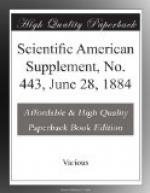Twenty-five years ago a house needed to be painted outside but once in from five to seven years; it looked well all the time, as no dust settled in the paint to make it unsightly. Painters then used the Dutch-process-made white-lead, a base and raw linseed oil, a fat acid, which formed the insoluble soap. They also put turpentine in the following coats, to keep up the proportions of oil and pigment. All held out well against wind and weather. Now they use the wet-process-made white lead, neutralized by vinegar, with oil neutralized by boiling, from the first to the last coat, and—fail in making their work permanent.
W.S., in the Building News, relates an unaccountable mysterious blistering in a leaky house, where the rainwater came from above on a painted wood wall, blistering the paint in streaks and filled at the lower ends with water, which no doubt was caused by the water soaking the wood at the upper ends where there was no paint, and following it down through the fibers, pushed and peeled off the soft, inadhesive paint. Green, sappy, and resinous wood is unfit for durable painting, and to avoid blistering and peeling wood should be well seasoned and primed with all raw linseed oil, some drier, to insure a moderately slow drying, and as much of a base pigment as the painter can possibly spread (much drier takes up too much oil acid, needed for the pigment base to combine with), which insures a tough paint that never fails to stand against blistering or peeling, as well as wind, weather, and ammonia.
The coach, car, and house painter can materially improve his painting where his needs lie by first oiling the wood with raw oil, then smoothing the surface down with lump pumicestone, washing it with a mixture of japan drier or, better yet, gold sizing and turpentine, wiping dry, and following it up with a coat of white lead, oil, and turpentine. The explanation is: the raw oil penetrates the wood and raises the wood fibers on the surface to be rubbed down with pumicestone, insuring the best surface for the following painting: to harden the oil in the wood it receives a coat of japan drier, which follows into the pores and there forms a tough, resinous matter, resisting any air pressure that might arise from within, and at the same time reacts on the first coat of lead as a drier. This mode insures the smoothest and toughest foundation for the following painting, and may be exposed to the hottest July sun without fear of either blistering or peeling.
Louis Matern.
Bloomington, Ill.
* * * * *
OLIVE OIL.
The following particulars with regard to the production of olive oil in Tuscany have been furnished to Mr. Consul Inglis by one of the principal exporters in Leghorn:
The olive oil produced in Tuscany from the first pressing of the fruit is intended for consumption as an article of food. Hence, great attention is paid both to the culture of the olive tree and the process of making oil.




